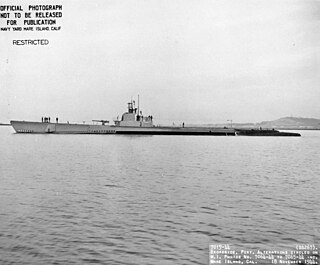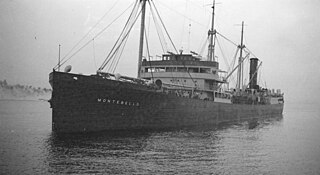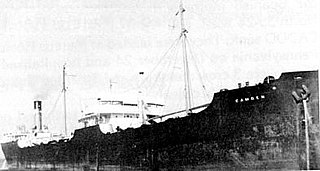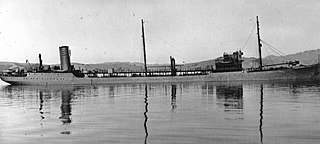Related Research Articles

USS Sargo (SS-188), the lead ship of her class of submarine, was the first ship of the United States Navy to be named for the sargo fish.

SS Absaroka was a steamer, named after the Absaroka Range of mountains in Montana and Wyoming, completed in February 1918 for the United States Shipping Board (USSB) which briefly operated the ship. From 17 September 1918 to 4 March 1919 the ship was commissioned as USS Absaroka with the identification number IX-2581 in United States Navy and operated by the Naval Overseas Transportation Service.

USS Pompon (SS/SSR-267), a Gato-class submarine, was a ship of the United States Navy named for the pompon, an American fish of the Anisot family.

The first USS Parche (SS-384/AGSS-384) was a United States Navy submarine. She bore the name of a butterfly fish, Chaetodon capistratus. Parche was a Balao-class submarine that operated in World War II.

The first USS Spadefish (SS/AGSS-411), a Balao-class submarine, was the first ship of the United States Navy to be named for the spadefish. Although she was commissioned late in the war and spent only one year in the Pacific war zone, she was able to run up a record of 88,091 tons in 21 ships and numerous trawlers sunk.

The T2 tanker, or T2, was a class of oil tanker constructed and produced in large numbers in the United States during World War II. Only the T3 tankers were larger "navy oilers" of the period. Some 533 T2s were built between 1940 and the end of 1945. They were used to transport fuel oil, diesel fuel, gasoline and sometimes black oil-crude oil. Post war many T2s remained in use; like other hastily built World War II ships pressed into peacetime service, there were safety concerns. As was found during the war, the United States Coast Guard Marine Board of Investigation in 1952 stated that in cold weather the ships were prone to metal fatigue cracking, so were "belted" with steel straps. This occurred after two T2s, Pendleton and Fort Mercer, split in two off Cape Cod within hours of each other. Pendleton's sinking is memorialized in the 2016 film The Finest Hours. Engineering inquiries into the problem suggested the cause was poor welding techniques. It was found the steel was not well suited for the new wartime welding construction. The high sulfur content made the steel brittle and prone to metal fatigue at lower temperatures.
I-21 was a Japanese Type B1 submarine which saw service during World War II in the Imperial Japanese Navy. She displaced 1,950 tons and had a speed of 24 knots (44 km/h). I-21 was the most successful Japanese submarine to operate in Australian waters, participating in the attack on Sydney Harbour in 1942 and sinking 44,000 tons of Allied shipping during her two deployments off the east coast of Australia.

SS Potrero del Llano was an oil tanker built in 1912. She sailed for a number of companies, and survived service in the First World War, only to be torpedoed and sunk by a German U-boat during the Second World War while sailing under the Mexican flag off the coast of Florida. Her sinking contributed to Mexico's decision to enter the war on the side of the Allies.

Montebello was a steam oil tanker built in 1920–1921 by the Southwestern Shipbuilding Co. of San Pedro for Union Oil Company with the intention of carrying oil and petroleum products along the West Coast of the United States and Canada as well as between the United States and Chile. In December 1941 the tanker was sunk on one of her regular trips by the Japanese submarine I-21.
The Torpedo Alley, or Torpedo Junction, off North Carolina, is one of the graveyards of the Atlantic Ocean, named for the high number of attacks on Allied shipping by German U-boats in World War II. Almost 400 ships were sunk, mostly during the Second Happy Time in 1942, and over 5,000 people were killed, many of whom were civilians and merchant sailors. Torpedo Alley encompassed the area surrounding the Outer Banks, including Cape Lookout and Cape Hatteras.
I-23 was a Type B1 submarine of the Imperial Japanese Navy during World War II. After a raid on the West Coast of California she participated in an attempt at a second attack upon Pearl Harbor. After surviving an American air attack on Kwajalein I-23 was lost in early 1942 with all hands somewhere off the Oahu coast of Hawaii.

California during World War II was a major contributor to the World War II effort. California's long Pacific Ocean coastline provided the support needed for the Pacific War. California also supported the war in Europe. After the Japanese attack on Pearl Harbor on December 7, 1941, most of California's manufacturing was shifted to the war effort. California became a major ship builder and aircraft manufacturer. Existing military installations were enlarged and many new ones were built. California trained many of the troops before their oversea deployment. Over 800,000 Californians served in the United States Armed Forces. California agriculture, ranches and farms were used to feed the troops around the world. California's long coastline also put the state in fear, as an attack on California seemed likely. California was used for the temporary and permanent internment camps for Japanese Americans. The population grew significantly, largely due to servicemen who were stationed at the new military bases/training facilities and the mass influx of workers from around the U.S. in the growing defense industries. With all the new economy activity, California was lifted out of the Great Depression. Over 500,000 people moved to California from other states to work in the growing economy. California expanded its oil and mineral production to keep up with the war demand.

Larry Doheny was a tanker ship that sank during World War II, after an attack by Japanese submarine I-25 on October 5, 1942, at 10:00pm. Larry Doheny sank with six of her crew killed off the coast of Cape Sebastian, off the southern coast of Oregon. Larry Doheny was on her way to Portland, Oregon loaded with 66,000 barrels of fuel oil from Long Beach, California. The torpedo attack caused the #2 and #3 storage tanks to explode. The explosion took out the radio, so no distress call was sent. The surviving 40 crew members were rescued by USS Coos Bay, a United States Navy Barnegat-class small seaplane tender, the next day. The ship was not salvaged. SS Emidio and SS Montebello were also attacked and sank off the West Coast of the United States. SS Larry Doheny was built by Sun Shipbuilding & Drydock Company. She had nine cargo tanks, her homeport was Los Angeles.
SS Dorothy Phillips was a 2,119-ton cargo ship that was attacked during World War II. The Japanese submarine I-23 fired at her on December 24, 1941. Dorothy Phillips was damaged in the attack off the coast of Monterey, California. In the attack the ship's rudder was damaged and the ship could not steer and ran aground. Dorothy Phillips was built in 1918 by Albina Engine and Machine Works in Portland, Oregon. The attack helped put fear into the west coast and started the Battle of Los Angeles. SS Emidio and SS Larry Doheny were also attacked and sank off the West Coast of the United States. Dorothy Phillips was built by Albina Engine & Machine Works in a shipyard along the Willamette River in Portland, Oregon, United States. Dorothy Phillips was produced as a freighters for World War I as Point Loma. In 1937 she was sold and renamed Dorothy Phillips. In 1946 she was sold and renamed Karen Olson. In 1957 she was sold and renamed Rio Tigre. In 1962 she was scrapped.

SS Camden was an American 6,653-ton tanker built by the New York Shipbuilding Company of Camden, New Jersey, for the Charles Kurz & Co. Inc. of Pennsylvania Shipping Company. She was operated by Shell Oil Company of Wilmington, Delaware. She was launched in 1921. The ship became famous when it was torpedoed early in World War II off the West Coast of the United States off Coos Bay, Oregon, at 43.38 N, –124.48 W at 7:00 am. She had departed San Pedro, Los Angeles, California, to Portland, Oregon, with fuel oil. The ship was attacked by Japanese submarine I-25 on October 4, 1942 off Oregon. She had been stopped for engine repairs at the time of the attack. She survived the attack, but later sank on October 10. One Crew member died and went down with the ship. The Camden was set on fire by the torpedo hit to her bow and was sinking. The crew abandoned ship and was rescued by a Swedish merchant ship, the MV Kookaburra. The Camden still on fire remained afloat. The tugboat Kenai was towing her to Astoria, Oregon, but then changed the path to Seattle, but the Camden sank off the coast of Washington state at 46.7772, -124.5208 and now rests at a depth of 312 feet.

SS Connecticut was a 8684 ton tanker ship built in 1938 by Bethlehem Shipbuilding Corporation and used for a World War II. She operated her under the United States Merchant Marine act for the War Shipping Administration, with United States Navy Armed Guards to man her deck guns. On December 28, 1941, the Connecticut was torpedoed near Cape Disappointment in the Pacific Ocean by I-25 of the Imperial Japanese Navy. To stop from sinking the Connecticut ran aground and was later salvaged. The attack took place 10 nautical miles off the mouth of the Columbia River near Oregon. The Japanese attack on the Connecticut was under the command of Lieutenant Commander Akiji Tagami.

H.M. Storey was an oil tanker built in 1921. She escaped an attack in California in 1941, but was sunk in an attack in 1943. She was owned by Standard Oil Company of California and built by Bethlehem Shipbuilding Corporation at the Alameda Works Shipyard with a hull# of 5312. She had a max. capacity of 306,115 gallons of fuel oil. Her keel was laid on January 19, 1921 and she was launched on September 28, 1921. Her sister ships are the SS F.H. Hillman and SS W.S. Rheem. She had a range of 7,717 miles, 10,763 DWT and a 16,000 ton displacement. She had a length of 500 feet, a beam of 68.2 feet and a draft of 30 feet. She had 2,700 hp, made by a triple-expansion engine with dual shaft and 2 screws. She had three Scotch boilers. Named for Henry Martin Storey, vice president of the Standard Oil Company.

The SS Agwiworld was a tanker ship that was able to evade an attack off the coast of California in the early days of World War II. Agwiworld was built by Sun Shipbuilding in Chester, Pennsylvania on the Delaware River. Agwiworld's keel was laid down on July 28, 1920. The vessel was launched on December 22, 1920, and delivered on January 19, 1921. Agwiworld was owned and operated by Richfield Oil Company and homeport was Los Angeles, California.

The SS Samoa was a 1,997-ton cargo ship that was able to escape an attack off the coast of California in the early days of World War II. The Samoa was built under a United States Shipping Board (USSB) contract in 1918 as the SS Muerthe, but was launched as the USS Lake Pepin, named after Lake Pepin, by the McDougall Duluth Shipbuilding Company of Duluth, Minnesota measured at 3,600 tons deadweight. She had a triple expansion engine steam engine with 1,250 horsepower (930 kW), a 251-foot (77 m) length, 43.5-foot (13.3 m) beam, a draft of 17 feet 8+1⁄2 inches (5.398 m), a top speed of 9.25 knots. The vessel had a crew of 52, with the hull # 9 and O.N.ID # 21699. The USS Lake Pepin was owned and operated by the United States Navy, commissioned at Montreal, Quebec, Canada on 4 September 1918. For World War I she was fitted with one 3"/50 caliber gun. The Navy put her in Naval Overseas Transportation Service as a coal carrier traveling between the United Kingdom and France as a United States Navy Temporary auxiliary ship. Her coal service ended in May 1919. In June 1919 she returned to the US with a cargo of World War I vehicles and weapons and unused ammunition. The US Navy decommissioned the Lake Pepin on 18 June 1919. In 1923 she was, renamed Samoa purchased and operated by the Hammond Lumber Company. In 1936 she was sold to the Wheeler Logging Company of Portland, Oregon. In February of 1941 she was sold to W. A. Schaefer Company.

SS Barbara Olson was a cargo ship built in Wisconsin in 1918 as the SS Corrales. Barbara Olson was able to escape an attack off the coast of California in the early days of World War II. The Barbara Olson was built under a United States Shipping Board (USSB) contract in 1918 as the SS Corrales and renamed in 1940. On July 25, 1942, she was chartered by the US Army to transport supplies to the Territory of Hawaii as the USAT Barbara Olson for World War II. On January 14, 1946, her Army service ended. In 1964 she was run aground four miles (6.4 km) north of Pimentel, Peru and declared a total loss.
References
- ↑ http://www.shipbuildinghistory.com Tankers and Navy Oilers]
- ↑ www.militarymuseum.org, Montebello
- ↑ merchantships2, ships
- ↑ Panic on the Pacific: How America Prepared for the West Coast Invasion, By Bill Yenne
- ↑ militarymuseum.org Victor Valley's Unsung Heros, by John Swisher
- ↑ Battle of Los Angeles
- ↑ USLO, The Armor of Democracy: Volunteerism on the Home Front in World War II California
- ↑ The Triumphant Partnership: California Cities and the Winning of World War II, California State University, Northridge, April 29, 2005
- ↑ Fourth Antiaircraft Command Brigadere, August 1945
- ↑ Panic on the Pacific: How America Prepared for the West Coast Invasion, By Bill Yenne